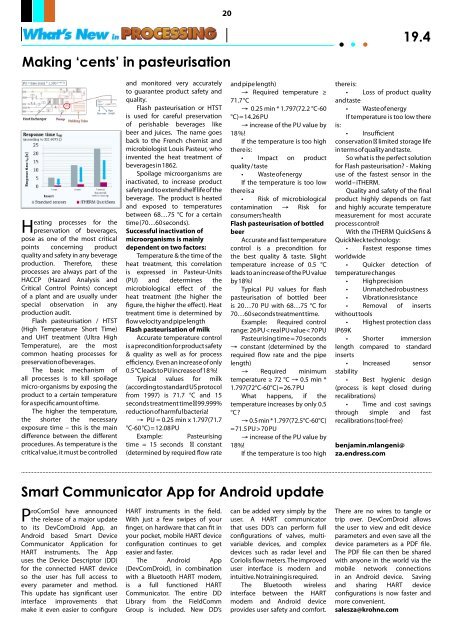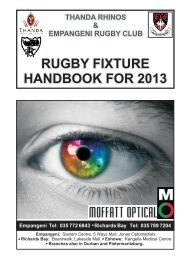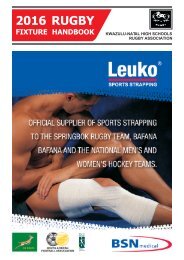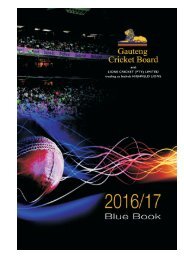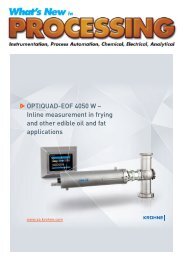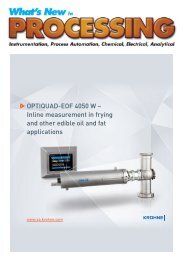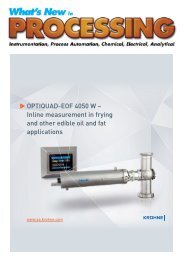WNIP JUL AUG 19.4 Digital
WNIP JUL AUG 19.4 Digital
WNIP JUL AUG 19.4 Digital
Create successful ePaper yourself
Turn your PDF publications into a flip-book with our unique Google optimized e-Paper software.
20<br />
<strong>19.4</strong><br />
Making ‘cents’ in pasteurisation<br />
Heating processes for the<br />
preservation of beverages,<br />
pose as one of the most critical<br />
points concerning product<br />
quality and safety in any beverage<br />
production. Therefore, these<br />
processes are always part of the<br />
HACCP (Hazard Analysis and<br />
Critical Control Points) concept<br />
of a plant and are usually under<br />
special observation in any<br />
production audit.<br />
Flash pasteurisation / HTST<br />
(High Temperature Short Time)<br />
and UHT treatment (Ultra High<br />
Temperature), are the most<br />
common heating processes for<br />
preservation of beverages.<br />
The basic mechanism of<br />
all processes is to kill spoilage<br />
micro-organisms by exposing the<br />
product to a certain temperature<br />
for a specific amount of time.<br />
The higher the temperature,<br />
the shorter the necessary<br />
exposure time – this is the main<br />
difference between the different<br />
procedures. As temperature is the<br />
critical value, it must be controlled<br />
and monitored very accurately<br />
to guarantee product safety and<br />
quality.<br />
Flash pasteurisation or HTST<br />
is used for careful preservation<br />
of perishable beverages like<br />
beer and juices. The name goes<br />
back to the French chemist and<br />
microbiologist Louis Pasteur, who<br />
invented the heat treatment of<br />
beverages in 1862.<br />
Spoilage microorganisms are<br />
inactivated, to increase product<br />
safety and to extend shelf life of the<br />
beverage. The product is heated<br />
and exposed to temperatures<br />
between 68…75 °C for a certain<br />
time (70…60 seconds).<br />
Successful inactivation of<br />
microorganisms is mainly<br />
dependent on two factors:<br />
Temperature & the time of the<br />
heat treatment, this correlation<br />
is expressed in Pasteur-Units<br />
(PU) and determines the<br />
microbiological effect of the<br />
heat treatment (the higher the<br />
figure, the higher the effect). Heat<br />
treatment time is determined by<br />
flow velocity and pipe length<br />
Flash pasteurisation of milk<br />
Accurate temperature control<br />
is a precondition for product safety<br />
& quality as well as for process<br />
efficiency. Even an increase of only<br />
0.5 °C leads to PU increase of 18 %!<br />
Typical values for milk<br />
(according to standard US protocol<br />
from 1997) is 71.7 °C and 15<br />
seconds treatment time 99.999%<br />
reduction of harmful bacteria!<br />
→ PU = 0.25 min x 1.797(71.7<br />
°C-60 °C) = 12.08 PU<br />
Example: Pasteurising<br />
time = 15 seconds constant<br />
(determined by required flow rate<br />
and pipe length)<br />
→ Required temperature ≥<br />
71.7 °C<br />
→ 0.25 min * 1.797(72.2 °C-60<br />
°C) = 14.26 PU<br />
→ increase of the PU value by<br />
18 %!<br />
If the temperature is too high<br />
there is:<br />
• Impact on product<br />
quality / taste<br />
• Waste of energy<br />
If the temperature is too low<br />
there is a<br />
• Risk of microbiological<br />
contamination → Risk for<br />
consumers’ health<br />
Flash pasteurisation of bottled<br />
beer<br />
Accurate and fast temperature<br />
control is a precondition for<br />
the best quality & taste. Slight<br />
temperature increase of 0.5 °C<br />
leads to an increase of the PU value<br />
by 18%!<br />
Typical PU values for flash<br />
pasteurisation of bottled beer<br />
is 20…70 PU with 68…75 °C for<br />
70…60 seconds treatment time.<br />
Example: Required control<br />
range: 26 PU < real PU value < 70 PU<br />
Pasteurising time = 70 seconds<br />
→ constant (determined by the<br />
required flow rate and the pipe<br />
length)<br />
→ Required minimum<br />
temperature ≥ 72 °C → 0.5 min *<br />
1.797(72°C-60°C) = 26.7 PU<br />
What happens, if the<br />
temperature increases by only 0.5<br />
°C ?<br />
→ 0.5 min * 1.797(72.5°C-60°C)<br />
= 71.5 PU > 70 PU<br />
→ increase of the PU value by<br />
18%!<br />
If the temperature is too high<br />
there is:<br />
• Loss of product quality<br />
and taste<br />
• Waste of energy<br />
If temperature is too low there<br />
is:<br />
• Insufficient<br />
conservation limited storage life<br />
in terms of quality and taste.<br />
So what is the perfect solution<br />
for Flash pasteurisation? - Making<br />
use of the fastest sensor in the<br />
world – iTHERM.<br />
Quality and safety of the final<br />
product highly depends on fast<br />
and highly accurate temperature<br />
measurement for most accurate<br />
process control!<br />
With the iTHERM QuickSens &<br />
QuickNeck technology:<br />
• Fastest response times<br />
worldwide<br />
• Quicker detection of<br />
temperature changes<br />
• High precision<br />
• Unmatched robustness<br />
• Vibration resistance<br />
• Removal of inserts<br />
without tools<br />
• Highest protection class<br />
IP69K<br />
• Shorter immersion<br />
length compared to standard<br />
inserts<br />
• Increased sensor<br />
stability<br />
• Best hygienic design<br />
(process is kept closed during<br />
recalibrations)<br />
• Time and cost savings<br />
through simple and fast<br />
recalibrations (tool-free)<br />
benjamin.mlangeni@<br />
za.endress.com<br />
Smart Communicator App for Android update<br />
ProComSol have announced<br />
the release of a major update<br />
to its DevComDroid App, an<br />
Android based Smart Device<br />
Communicator Application for<br />
HART instruments. The App<br />
uses the Device Descriptor (DD)<br />
for the connected HART device<br />
so the user has full access to<br />
every parameter and method.<br />
This update has significant user<br />
interface improvements that<br />
make it even easier to configure<br />
HART instruments in the field.<br />
With just a few swipes of your<br />
finger, on hardware that can fit in<br />
your pocket, mobile HART device<br />
configuration continues to get<br />
easier and faster.<br />
The Android App<br />
(DevComDroid), in combination<br />
with a Bluetooth HART modem,<br />
is a full functioned HART<br />
Communicator. The entire DD<br />
Library from the FieldComm<br />
Group is included. New DD’s<br />
can be added very simply by the<br />
user. A HART communicator<br />
that uses DD’s can perform full<br />
configurations of valves, multivariable<br />
devices, and complex<br />
devices such as radar level and<br />
Coriolis flow meters. The improved<br />
user interface is modern and<br />
intuitive. No training is required.<br />
The Bluetooth wireless<br />
interface between the HART<br />
modem and Android device<br />
provides user safety and comfort.<br />
There are no wires to tangle or<br />
trip over. DevComDroid allows<br />
the user to view and edit device<br />
parameters and even save all the<br />
device parameters as a PDF file.<br />
The PDF file can then be shared<br />
with anyone in the world via the<br />
mobile network connections<br />
in an Android device. Saving<br />
and sharing HART device<br />
configurations is now faster and<br />
more convenient.<br />
salesza@krohne.com


